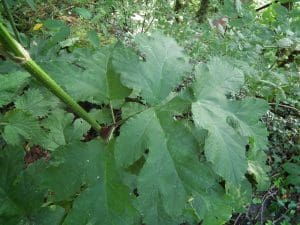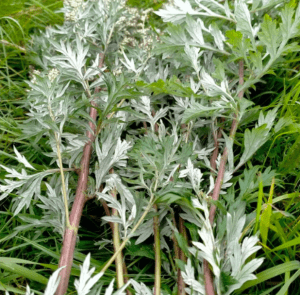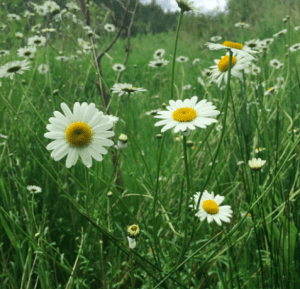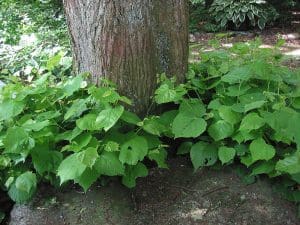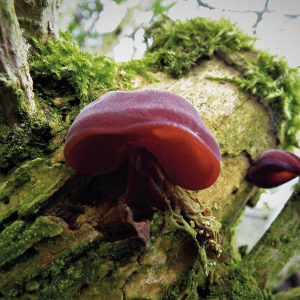Through this piece we’re going to look at how we enjoy Foraging in Summer, we’ll be taking a look at coastal foraging in the lower and upper tides, throughout the marsh lands before jumping back on the mainland to see what we enjoy foraging inland throughout summer. I’ll link you up with some of my favourite summer foraging recipes so you can have a play with all of these ingredients when we’re back in the kitchen!
“ In my opinion Summer hasn’t really begun until the Elder is in full bloom; and it ends when its berries are ripe”
This year a foraging colleague in Glasgow reported that the Elders up there were still in full bloom when the Elderflowers near me, in Norfolk were pretty much gone. The colours of summer unfurl from south to north, with the rise in temperature and from east to west with local variations in climate and soils. When the forager’s summer starts and ends is not something we can accurately predict. It’s unique to everyone and every location, which is the beauty of foraging within the seasons.
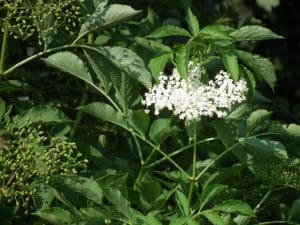
The leaves of many plant species get smaller in summer as the plants put more energy into producing flowers. This can make foraging for leaves a bit more time consuming and fiddly but it is a good time to confirm that the leaves you saw in spring actually do belong to the plant you thought they did. Once confirmed, it’s worth checking if the flowers are edible so you can use them to brighten up your culinary creations. They often have added health benefits too.
Elder trees, found on sunny edges of woodlands, hedgerows, footpaths and fields, blossom just in time for the hay fever season. They are anti-asthmatic, anti-allergenic, soothing to an inflamed respiratory tract and a good source of Vitamin C. Elderflowers make a delicious cordial or sparkling wine or can be dipped in tempura batter and fried to make delightful Elderflower Fritters.
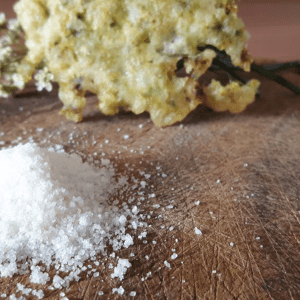
Nettles come into flower in the summer months too. As the flowers develop the leaves become gritty due to the increase in insoluble calcium carbonate crystals, which can cause discomfort to the kidneys. Nettle seeds are found on female plants and are high in protein and omega oils. A tea made from nettle seeds is highly stimulating and a tonic for low energy or burn-out. But don’t drink it just before bed-time!
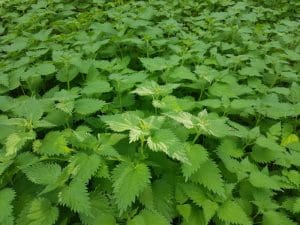
Lets’ take a Trip to the Coast
Is a great idea on a hot summer’s day.
The cool breeze blowing from the sea, paddling in the waves and a good chance of finding seaweed.
Seaweeds are the most highly mineralised vegetables on earth, accumulating and concentrating minerals directly from the sea. They are also high in vitamins, antioxidants, protein and soluble fibre. Some seaweeds, such as sea lettuce, can be eaten raw as part of a salad; others are best dried and ground to a powder to add flavour to cooked dishes or fried until crispy.
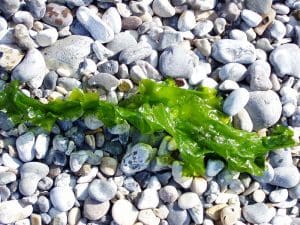
In the UK, seaweeds growing close to shore are not poisonous. Only take the top few centimetres (they get tougher further down the fronds) and only take cuttings from fronds that are attached by a holdfast. Fronds that are floating freely may have come from further out at sea where the water may be more polluted and where poisonous species can be found.
A summer treat from the sand dunes is Sea Buckthorn. Their bright orange berries ripen from August right through to December. The berries make a wonderful sour juice with a vitamin C content up to nine times higher than other citrus fruits and vitamin B12, an important nutrient for people who have removed meat from their diet, while the seeds are high in vitamin E
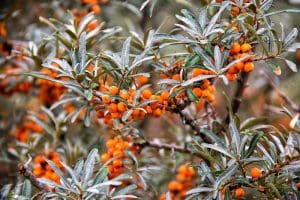
The saltmarsh comes into its own in the summer months and provides succulent, salty species such as Marsh Samphire, Sea Aster, Sea Blite and Sea Purslane, each with their unique textures and flavours and specific niches within the marsh. To survive the challenge of twice daily washing and drying in water, salt sun and wind, the saltmarsh plants lock minerals and nutrients into their structure, making them a highly nutritious and delicious addition to the foragers’ diet.
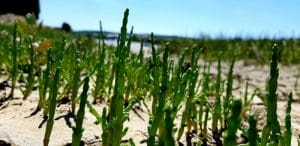
Just above high tide
and low enough to have its feet washed occasionally by the tide, I often find stands of Frosted Orache. A bite sized leaf with a firm texture makes it a good addition to a salad. Surprisingly it is in the same family (Goosefoot) as Samphire, Sea Blite and Sea Purslane, which all look completely different to each other. Another member of this family is Sea Beet – occasionally found at the high tide mark but usually elevated just enough to avoid the highest tides. Sea beet is a great substitute for spinach and has a higher iron content. Both Orache and Sea Beet are quite high in oxalic acid so should be avoided by people with kidney stones.
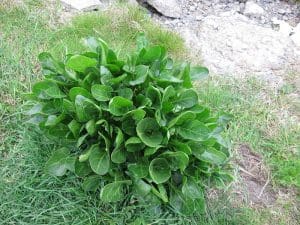
Mallow is a common coastal plant which flowers from May to September. A mucilaginous, slightly astringent herb that is expectorant, soothes sore throat and respiratory problems. The whole plant is edible with a mild flavour. Flash fried, the leaves make a lovely crispy snack, or you can put the whole plant into a blender and use its mucilaginous quality as a base for soup or to bind bread. The seeds are little round “cheeses” that have a nutty flavoured crunch.
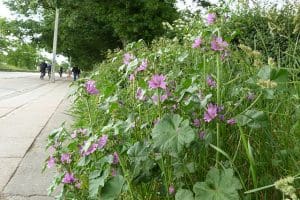
Along the North Norfolk coast, where I live, Alexanders are prolific and invasive, outcompeting many of our native species. The creamy yellow umbels which swathed roadsides, field margins and sea walls in spring are replaced, in summer, by the polka dot pattern of their black, peppercorn sized seeds. The seeds can be ground to make a perfumy pepper – a strong flavour which is “an acquired taste” but worth experimenting with.
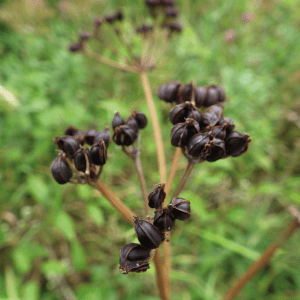
After the Alexanders’ bloom has faded the bright yellow canopies of fennel are seen, towering elegantly amongst bordering vegetation. Their delicate lacey leaves and cheery yellow flowers add a strong aniseed tang to brighten up a salad or stir fry. Leaf stalks and stems can be used as a vegetable or added to soups and stews. Flowers can be added to sweet or savoury sauces and dressings or fried in tempura batter. Fennel pollen is prized for the intensity of its flavour. Seeds can be used as a spice, to make tea or used in flavouring bread or oil. The flavour of leaf, bud and flower can also be retained in spirits such as vodka or schnapps.
Lets’ Head a little Further Inland
Common spring-time umbellifers, such as the innocuous Cow Parsley, deadly Hemlock, poisonous Rough Chervil and Fools Parsley, die back in the summer. But microclimates and regional variations mean they may still be present. So please scrutinise all umbellifers thoroughly before picking.
You’re unlikely to mistake those fine, feathery-leaved poisonous species for Hogweed with its sturdy, white, compound umbels and much larger, lobed leaves. However, do check the identification guides comparing Common Hogweed with Giant Hogweed which has high concentrations of furanocoumarins which cause phytophotodermatitis. Some people have a reaction to the less concentrated furanocoumarins in Common Hogweed sap as well. Common Hogweed leaves are best when they are young and just starting to unfurl but, when mature, they are still good to chop up and add to cooked dishes. Young leaves can still be found unfurling along the flowering stems in summer and are nice simmered in a little butter with a splash of lemon. Common Hogweed seeds can be used as a spice in place of cardamon.
Wild Carrot does have fine, feathery leaves and the densely clustered, single, white umbels are recognisable by the ruff of delicately curved, three forked bracts beneath. Wild Carrots often have a single red or dark purple flower in the centre of their flat-topped, heads – purported to be a drop of Queen Anne’s blood when she pricked her finger while making lace. Hence the colloquial name of Queen Anne’s Lace. Once the flowers of Wild Carrot have been pollinated the umbels curl up and look like a miniature bird’s nest on a stick. When dried these seed heads detach and become tumbleweeds. The leaves and flowers can be eaten raw or cooked and the seeds can be added to breads and stews, imparting hints of citrus, cumin coriander and carraway. Wild carrot can also cause phytophotodermatitis and should not be eaten during pregnancy or breast feeding.
The best time to harvest Mugwort is just as it comes into flower, which can be from July to September. Flower heads are more aromatic and offer an allusive flavour to soups and casseroles, described variously from menthol to sage. Young stems can be peeled and eaten raw or cooked. Young leaves are tender enough to add to salads or can be made into a tea or bedtime drink to stimulate vivid and lucid dreams; or blend the leaves with herbs like mint, sage and fennel for a digestive tea, rich in Vitamin C and unsaturated fatty acids.
At the end of July, Willowherb is reaching up to its full height, forming a fiery pink backdrop along roads, fields, and waterbodies, with its spikes of numerous four–petalled flowers. The stems of Willowherb are quite tough in the summer when the lanceolate leaves unfurl in spirals around the stem and can be dried to make tea or included in salads. The leaves add a bitterness which awakens the taste buds, stimulates digestion and provides a healthy dose of vitamins A and C. The flowers add a colourful splash to salads and are less bitter than the leaves.
Daisies make a lovely addition to a salad and if you can find Ox Eye Daisies, even better. The leaves have more vitamin C than lemons and they contain saponins that stimulate collagen production in cells, helping to maintain their elasticity.
Many of the mint family enjoy the hot dry conditions of summer. The presence of aromatic oils enables them to retain moisture and also repel insects and herbivorous predators. The mint family includes the Red and White dead nettle, Ground Ivy and Self Heal, whose earthy flavours are not immediately recognisable as mint. But it is a treat when a refreshing, minty-flavoured mint such as Water Mint presents itself to compliment a fruity dessert. And, of course, summer is a great time to find hedgerows and trees adorned with cherries, plums, apples and blackberries. Another tasty addition to desserts are the crunchy petal-less flower heads of Pineapple Weed. Sometimes called Wild Chamomile it has many of the same benefits as chamomile, being good for relaxation and promoting sleep.
In the cool shade of woodlands
Low growing herbs like Ground Ivy, Ground Elder and Herb Robert can still be found. These are tasty additions to salads or cooked dishes if added at the end of cooking to prevent loss of bulk, flavour and nutrients.
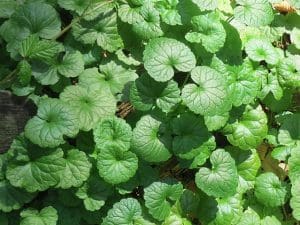
The leaves of many trees are edible but most are too tough to eat in summer. It is possible to find young, edible Common Lime leaves in early summer, particularly where you get many branches sprouting from the base of the trunk. The blossom of Lime, also known as Linden flowers, is available in early summer. These can be used to make teas, syrups, tinctures and honey, which have the benefits of promoting relaxation and helping with respiratory issues.
Lime leaves at the base of a tree
The cooler, less dry conditions of woodland also favour mushrooms and there are a surprising number of different mushrooms to be found in the summer months. Living on the North Norfolk coast, with only occasional visits inland, means I haven’t had much success in finding mushrooms. The edible ones I have identified with 100% certainty are Dryads Saddle and Jelly Ear. Never eat a mushroom unless you are 100% certain you know what it is.
Conclusion
We’ve only just pricked the surface of the fantastic edible potential that foraging in summer can offer and we’ve already got ourselves over 10 ingredients and 50, going on 1000, recipes that I’m truly excited to jump straight into.
So grab your basket, secateurs and foraging book and lets head out foraging!



